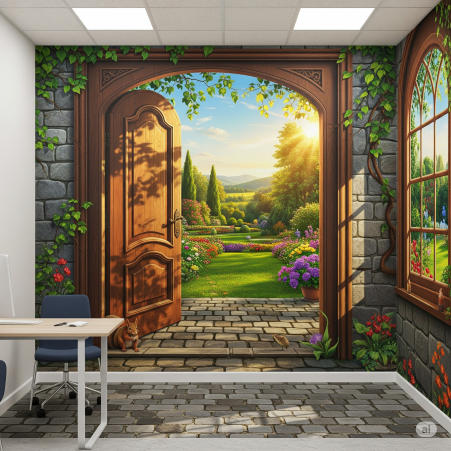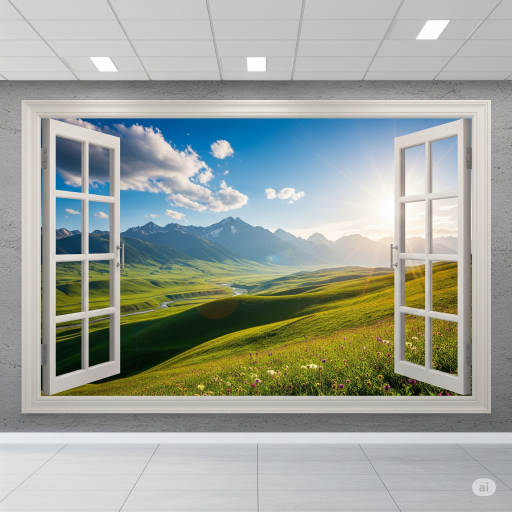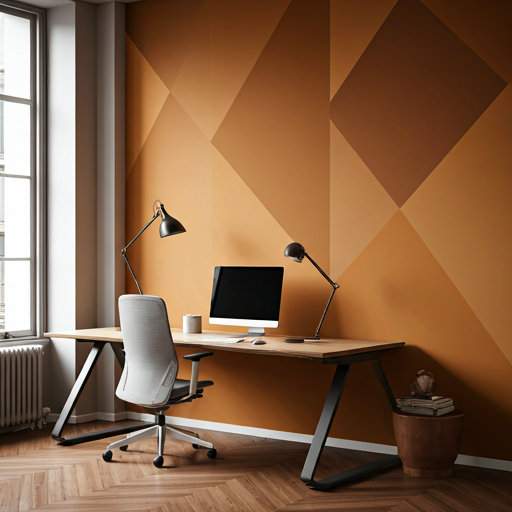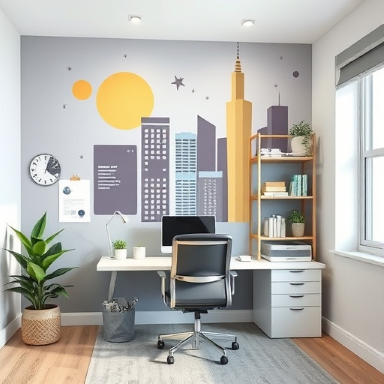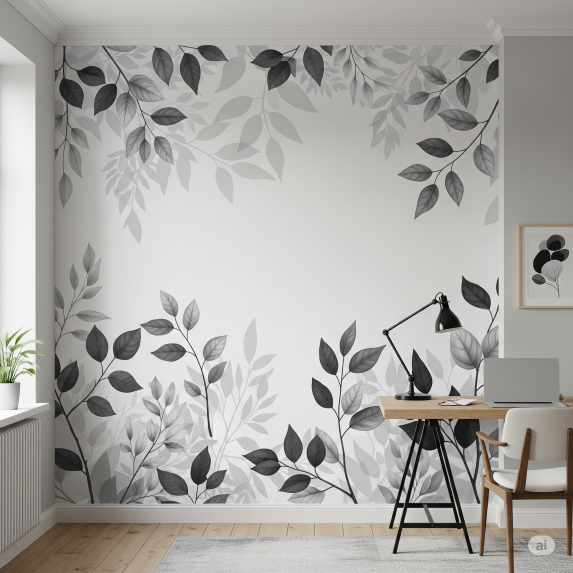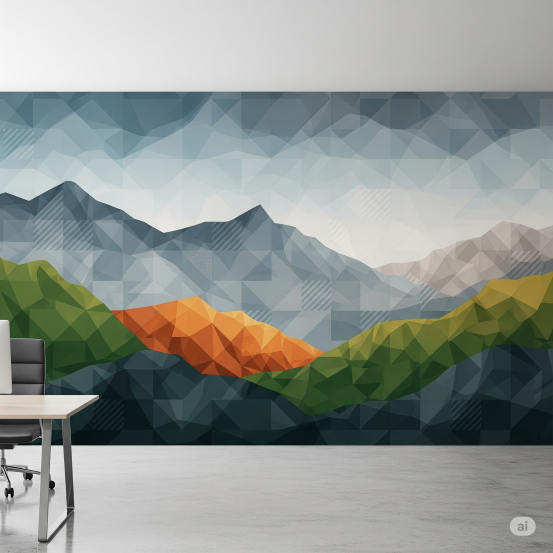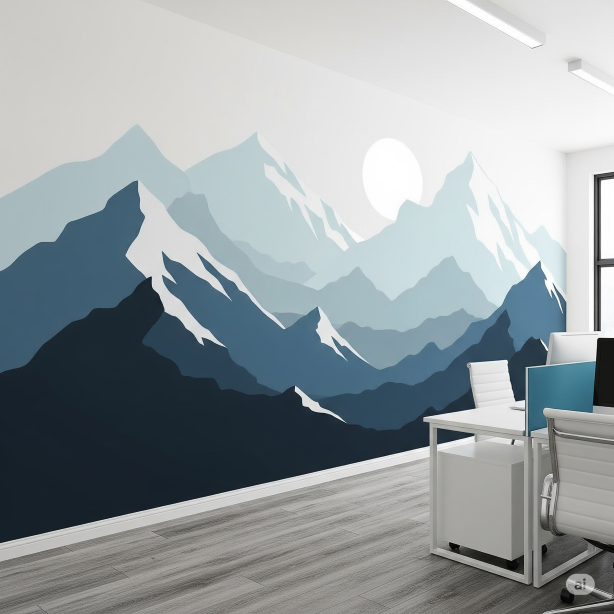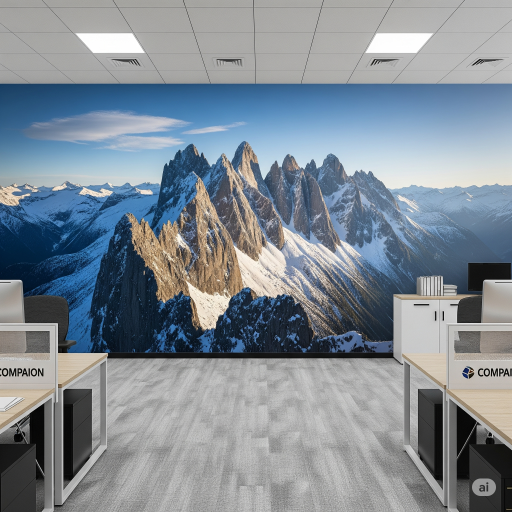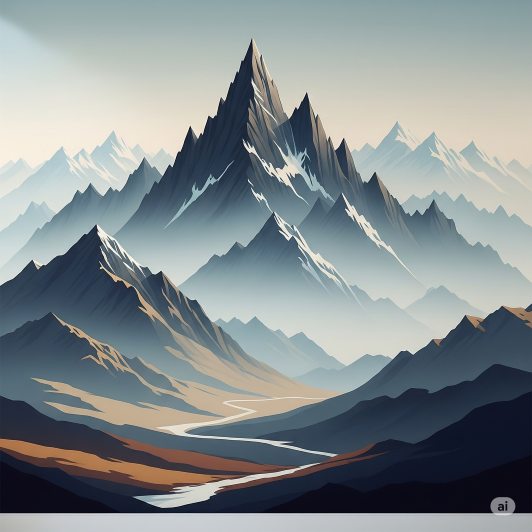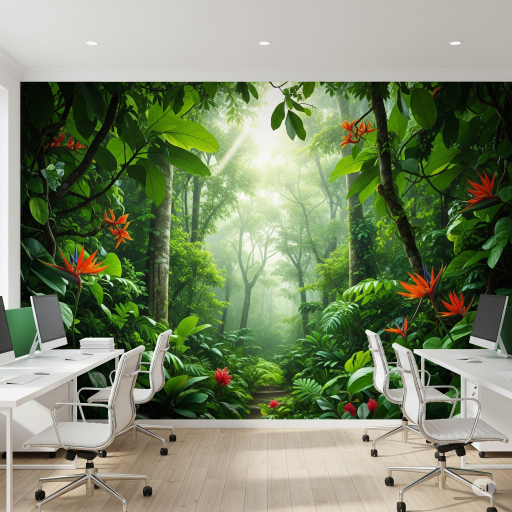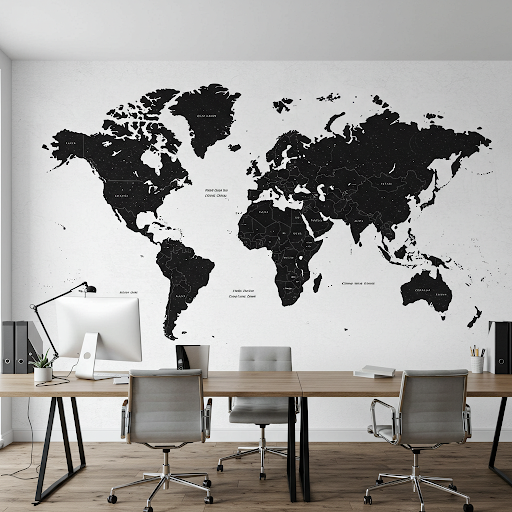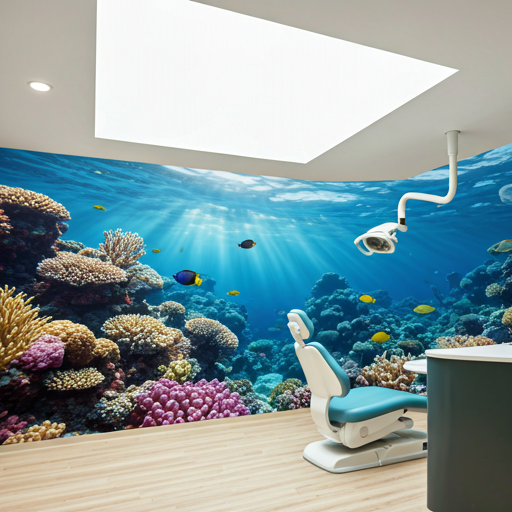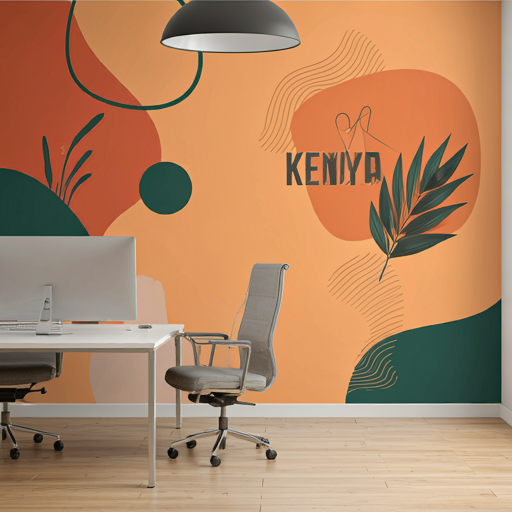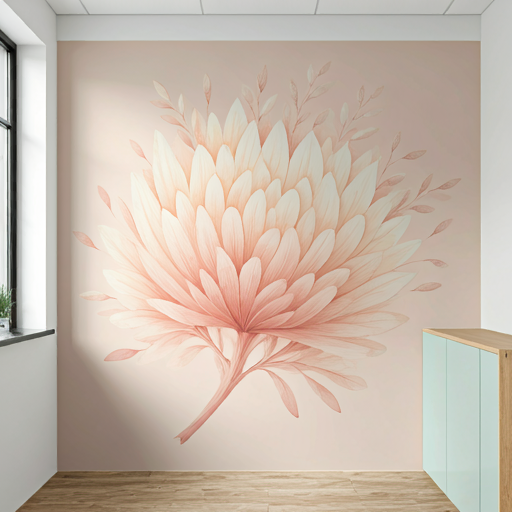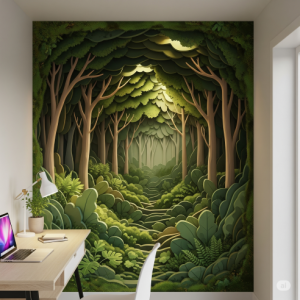Description
Professional and Inspiring Small Office Mural Art
Small office mural art transforms compact spaces with strategic design. It employs simplicity, light colors, and proportional scale to create an illusion of openness. And prevents the room from feeling cramped. This art serves as a subtle, impactful focal point that can reflect company values and culture. By utilizing minimalist typography, geometric patterns, or calming, nature-inspired themes, a well-designed mural adds character and sophistication without overwhelming the limited space. The result is a thoughtfully curated environment that feels both professional and inspiring.
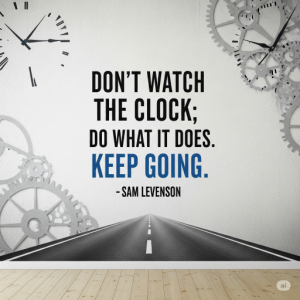
The primary purpose is to:
Create a focal point with a small office mural

A small office mural serves as a powerful visual anchor. Immediately draws the eye to a specific area and makes the room feel more intentional and professionally designed. In a compact space where every element counts, the mural acts as the main attraction. It gives the room a sense of purpose and character. This powerful visual anchor adds depth and personality, turning an otherwise blank wall into a meaningful statement that reflects the company’s unique style and culture. It transforms the space from a simple workplace into an environment with a clear identity.
Reflect the company culture

Small office murals are an excellent way to visually represent and reinforce company culture. Especially in limited spaces where other design elements might be minimal. The mural becomes a constant, non-verbal reminder of the company’s identity and values. This can be achieved through several strategic approaches:
Inspirational Typography

A thoughtfully designed mural featuring the company’s mission statement, a core value, or an uplifting quote serves as a daily source of inspiration for employees. This constant visual reinforcement helps to align everyone with the company’s purpose and fosters a positive, motivated work environment.
Brand Storytelling

The mural can be used to tell the company’s story. By visually depicting key milestones, the brand’s journey, or its founding principles, the mural fosters a sense of shared history and pride among employees. It can serve as a conversation starter for new hires and a nostalgic reminder for long-term staff, strengthening a collective identity.
Thematic Imagery

The mural’s design can be a direct reflection of the company’s industry or ethos. For a tech company, this might involve abstract representations of code or interconnected networks, while a wellness brand could benefit from calming, nature-inspired scenes. These thematic visuals create a powerful and subconscious connection between the physical space, the work being done, and the brand’s overall identity.
Create an illusion of space with small office mural art

Clever design techniques can make a small room feel larger, taller, or more open. Here are some tips on how to create an illusion of space with small office mural art:
Horizon Lines and Perspective
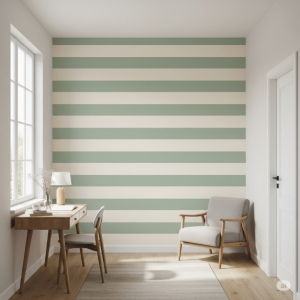 A mural that uses a visible horizon line or linear perspective is a powerful tool for creating the illusion of depth. By depicting a scene with a vanishing point, such as a road disappearing into the distance or a landscape with a clear horizon, the mural draws the eye inward. This technique tricks the brain into perceiving the flat wall as a three-dimensional window into a larger space, making the room feel more expansive and less confined.
A mural that uses a visible horizon line or linear perspective is a powerful tool for creating the illusion of depth. By depicting a scene with a vanishing point, such as a road disappearing into the distance or a landscape with a clear horizon, the mural draws the eye inward. This technique tricks the brain into perceiving the flat wall as a three-dimensional window into a larger space, making the room feel more expansive and less confined.
Vertical Lines
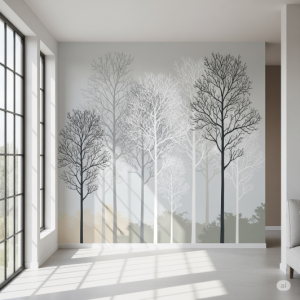
To visually increase a room’s height, incorporate strong vertical elements into the mural. Designs featuring tall, slender trees, a cityscape with towering buildings, or even simple, thin vertical stripes can draw the gaze upward. This visual movement elongates the wall, making the ceiling appear taller and the room feel more open and airy.
Light Colors and Minimalist Designs
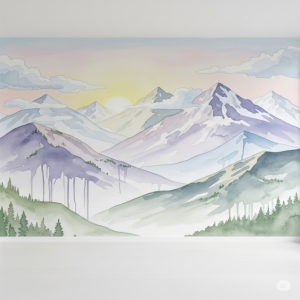
The choice of color and design is crucial for making a small space feel bigger. A light, airy color palette—think pastels, whites, or muted tones—reflects light and makes the room feel brighter and more open. Pair this with a simple, minimalist design to prevent the mural from feeling heavy or overwhelming. An uncluttered mural with ample negative space helps to maintain a sense of calm and openness. It is better than creating a visually dense and enclosed environment.
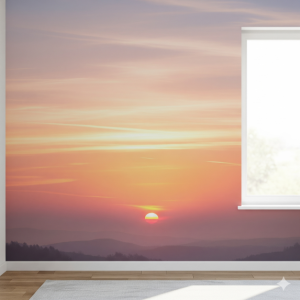
Mirrors and Reflections
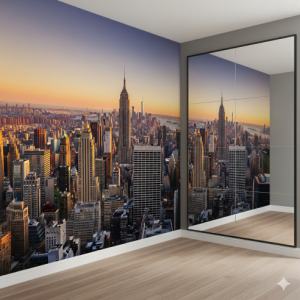
Incorporating mirrors or reflective elements directly into the mural is an ingenious way to create a sense of spaciousness. A mural that depicts a shiny, reflective surface or even a subtle shimmer can fool the eye into perceiving more light and space. Placing a mirror in the mural’s composition can create a false sense of an adjoining room. And instantly expands the visual footprint of the office.
These techniques help a small office feel more open and expansive, transforming a cramped area into a welcoming environment.
Small office mural art design principles
Simplicity and Minimalism
![]()
For a small office mural, a minimalist approach is key to avoiding a cluttered look. Focusing on simple geometric shapes, clean lines, and a limited color palette ensures the design adds visual interest without overwhelming the small space. This design philosophy creates a sense of calm and order, making the office feel more professional and less chaotic. Think of it as a subtle enhancement, rather than a dominant feature.
Small Office Mural Strategic Placement
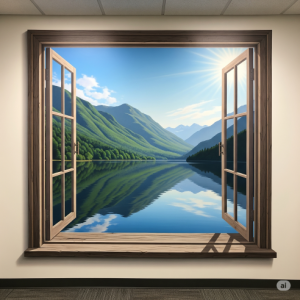
The mural’s location can significantly impact its effect on the office environment. Placing a mural behind the reception desk can create a strong first impression for clients, setting a welcoming and professional tone. In a small meeting room, a mural can serve as a focal point, inspiring creativity and conversation. Alternatively, a mural in a hallway can break up a monotonous corridor, turning a simple path into a visually engaging journey. The key is to choose a location that enhances the room’s function and purpose.
Proportionality

The mural’s size and complexity must be in proportion to the wall and the surrounding furniture. An excessively large or intricate mural on a small wall can make the room feel cramped and unbalanced. Instead, opt for a design that fits the scale of the wall, leaving enough negative space to prevent a crowded feeling. This thoughtful approach ensures the mural feels like a natural part of the room’s design, rather than a jarring addition.
Color Psychology
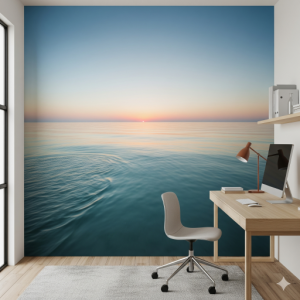
The colors you choose for your mural can drastically influence the mood and perception of the space. Lighter, airy colors such as pastels, soft blues, and light greens can make a small room feel larger and more open by reflecting light. On the other hand, brighter, more vibrant colors can be used strategically as accents to inject energy and personality into the space, creating a modern and dynamic atmosphere. The goal is to find a balance that energizes without being overwhelming, contributing positively to employee morale and productivity.
Common Small Office Mural Art Styles and Themes
Due to the limited space, certain styles work better for small office murals:
Geometric Patterns
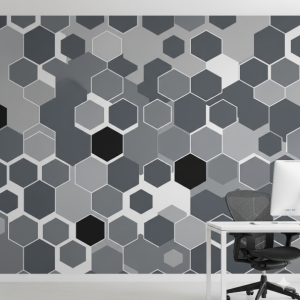
Geometric patterns are an excellent choice for a small office mural because they create a modern, minimalist aesthetic. Using simple shapes like triangles, circles, or hexagons with clean lines prevents the design from feeling cluttered. This style adds visual interest and a sense of order to the space, making it feel more intentional and organized. They can also be customized with a brand’s color palette to subtly reinforce company identity.
Abstract Art
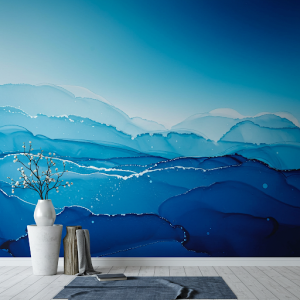
Abstract murals offer a sophisticated and artistic touch. These designs are highly versatile and can be tailored to fit the company’s brand, mood, and color scheme. Since abstract art doesn’t represent a specific object, it can be open to interpretation, sparking creativity and conversation. This style can transform a plain wall into a dynamic focal point without making the room feel smaller, as long as the color and scale are managed appropriately.
Nature-Inspired Murals
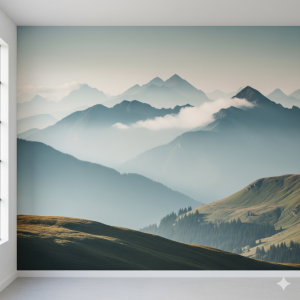
Bringing elements of nature indoors, a concept known as biophilic design, can have a calming effect. In a small office where employees spend long hours, a mural featuring simple leaves, subtle landscapes, or stylized trees can reduce stress and improve well-being. These designs create a connection to the natural world, making the space feel more serene and open, which is especially beneficial in a confined environment.

Minimalist Office Mural Typography
A mural focused on minimalist typography is a powerful and understated way to decorate a small office. A well-designed quote, a company mantra, or even a single word can inspire and motivate employees. The focus is on the message itself, with the clean typography serving as a strong visual element. This style is impactful yet avoids the visual noise of a more complex mural. It’s a great option for reinforcing company values and culture.
Subtle Branding
Instead of using a large, overpowering logo, a subtle branding mural integrates brand elements in a more sophisticated way. This could involve incorporating the company’s official colors into a geometric pattern, using a stylized version of the logo as a repeating motif, or even subtly hiding the brand’s name within a larger design. This approach reinforces brand identity without being overly promotional, creating a professional and refined look that feels integrated into the office’s design.
Practical Considerations

Before commissioning a small office mural, consider the following:
Wall Texture
A smooth wall surface is ideal for a clean, sharp-looking mural. Textured walls can make detailed designs look messy.
Lighting
How is the room lit? Natural light and artificial light can change how a mural’s colors and details are perceived.
Flexibility
If the company is growing or changing, a less permanent solution like a vinyl decal or a framed mural might be a better choice.
Artist Selection

Work with an artist who understands the unique challenges of designing for a small space. They should be able to create a design that enhances, rather than detracts from, the room.


